PRUNING TIPS



























10 Fifty years of wine
One man’s maverick move saw Montana kick start Marlborough’s wine industry in 1973. Fifty years on we look back at those early days and some of the key players.
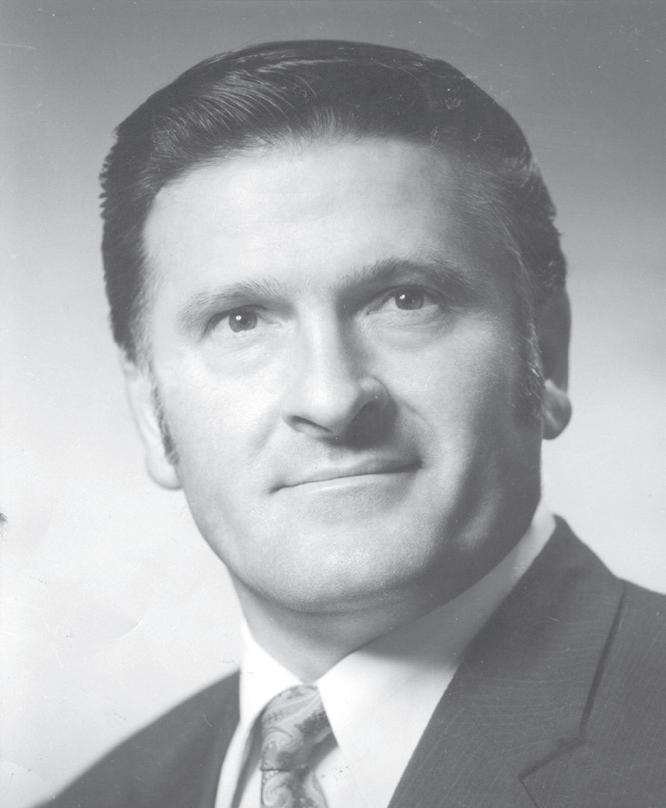

14 Pruning tips

With pruning progressing across Marlborough’s 29,650 hectares of vineyard area, it’s vital to ensure growers, contractors, workers and wine companies work together for the best results..
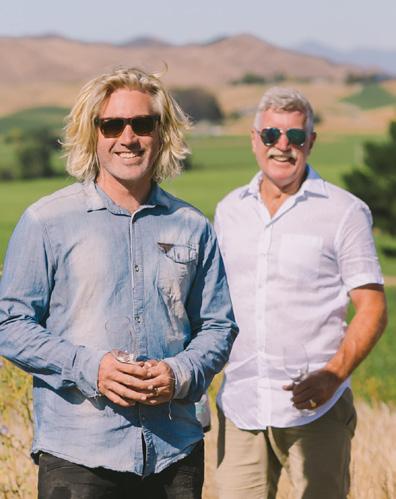
16
Cover: Spy Valley good sports from left, laboratory manager Vera Amorim, assistant winemaker Ashley Stace, and winery manager Jassi Brar. Photo Jim Tannock. See page 12
Tiraki B Corp
A bottle of bad quince schnapps proved perfect motivation for a family wine business focussed on environmental and social good.
• Commercial & Industrial Electricians

• Automation & Control systems
• Winery Upgrades
• Winery Design & Build
24/7 EMERGENCY CALL OUT
Phone: 0274 497 689
Email: admin@electratech.co.nz
Website: www.electratech.co.nz

Your local specialists for over 40 years
Repairs - call 24/7
Maintenance & Service
Hire Chiller Solutions
Design & Installation
SUPPLIERS OF:
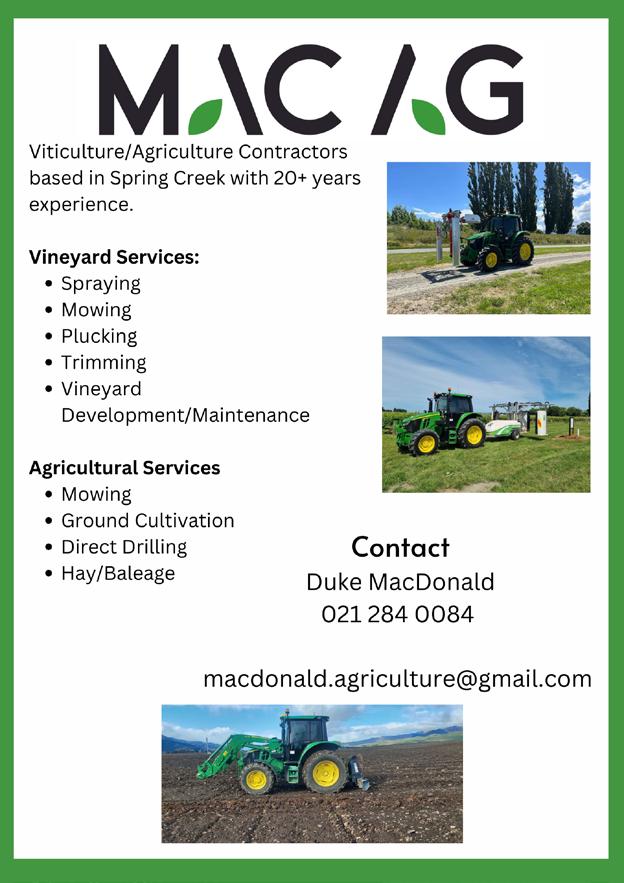
n Vineyard posts & strainers
n Quality timber products
n Utility buildings - designed for your needs
n Locally owned
n Working towards the betterment of Marlborough

TOP DEALS / TOP SERVICE

163 Hammerichs Road, Blenheim
Ph 03 578 0221 Fax 03 578 0251
sales@rapauratimber.co.nz
General Manager:
Marcus Pickens 03 577 9299 or 021 831 820 marcus@winemarlborough.nz
Editor:
Sophie Preece 027 308 4455 sophie@sophiepreece.co.nz
Marketing and Communications:
Sarah Linklater 021 704 733 sarah@winemarlborough.nz
Events Manager:
Loren Coffey loren@winemarlborough.nz
Advocacy Manager:
Nicci Armour advocacy@winemarlborough.nz
Advertising:
Joanna May advertising@winemarlborough.nz
Grape Grower Directors: Andrew Nation nationa@gmail.com
Anna Laugesen anna@craiglochart.co.nz
Michiel Eradus michiel@eraduswines.co.nz
Nigel Sowman nigel@dogpoint.co.nz
Tracy Johnston tracy@dayvinleigh.co.nz
Wine Company Directors:
Beth Forrest beth@forrest.co.nz
Damien Yvon damien@closhenri.com
Gus Altschwager gus@akwines.net
James Macdonald james@hunters.co.nz
Jamie Marfell Jamie.Marfell@pernod-ricard.com
Designed by: Blenheim Print Ltd 03 578 1322
Disclaimer: The views and articles that are expressed and appear in Winepress are entirely those of contributors and in no way reflect the policy of the Marlborough Winegrowers. Any advice given, implied or suggested should be considered on its merits, and no responsibility can be taken for problems arising from the use of such information.
This document is printed on an environmentally responsible paper, produced using elemental chlorine free (EFC), third party pulp from responsible sources, manufactured under the strict ISO 14001 Environmental Management System and is 100% Recyclable.
Spy Valley Wines and Yealands Wines for taking awards in the inaugural Marlborough Wine Industry Wellness Week. I have loved talking to people at these companies about their commitment to a safe, happy and healthy workforce, operating in a culture of care and consideration. I loved it so much that the Yealands story, ranging from period products in the workplace to a physio and psychiatrist on hand over vintage, will be told in the July edition, to give it the space it requires.
In this edition I share just a taste of the wellbeing work at Spy Valley (page 12), winner of the first ever Marlborough Wine Industry Workplace Wellbeing Impact Award, canvassing core values, cricket matches, and the care of a homemade cake. Marketing manager Della Offord talks of the family-focussed

philosophy managing director Amanda Johnson carries with her personally and imbues within the team. “The key thing that shines through is that it’s very genuine.” In a tight labour market, bosses like that are surely sought out.
Congratulations too to the organisers of the Organic & Biodynamic Winegrowing Conference on in Blenheim this month, after a four-year Covid-19 hiatus. The programme is jammed with an exciting line-up of speakers that’ll surely engage grape growers, winemakers and marketers. The June Wine Marlborough podcast hosts organic stalwart Bart Arnst and Loveblock’s Erica Crawford, seeking insights into the challenges and opportunities in the vines and in the wines, as well as in the markets. Their thoughts, and a run-down of the conference programme, can be found on page 19 of this edition.
Finally, congratulations to the Marlborough District Council’s economic development team for their second successful Techweek (see page 4) and to Wine Marlborough and council for paving the way for WinePRO, an international wine trade event to be held in Blenheim next winter (see page 15). “This event is an opportunity for us to celebrate New Zealand’s international reputation as a wine producer, as well as cement Marlborough’s place as a hub of technology and innovation,” says Marlborough Mayor Nadine Taylor.
SOPHIE PREECE
In a tight labour market, bosses like that are surely sought out.
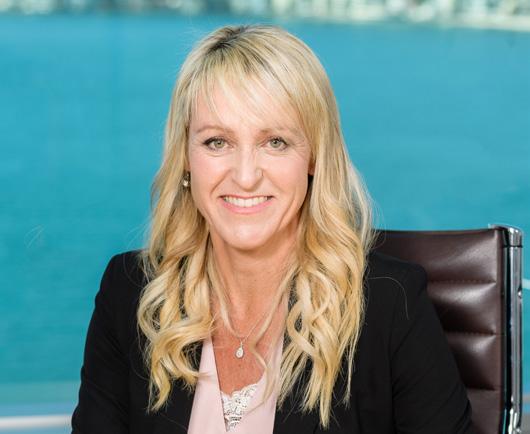
MARLBOROUGH’S SYNERGY of innovation, industry and investors is launching Kiwi technology into the world. It perhaps sounds unlikely that a region that represent less than 1% of New Zealand’s population could become the leading hub of agritech in Australasia, but that’s the goal of the Marlborough Economic Wellbeing Strategy. And we’ve got all the ingredients we need, including a wine industry hungry for innovation and one of the most active angel investment groups in New Zealand, helping early-stage companies commercialise their technology on a global stage. Add amazing innovators into the mix, and Marlborough has a unique and valuable edge.
I’m proud to have been on the board of Angel Investors Marlborough (AIM) for the past four years, and to have the privilege of working with a number of start-ups, especially in the agri-tech space. Since it began in 2017, AIM has invested $23 million into 61 start-ups, and now has 157 members in New Zealand and abroad. Our investments are sector agnostic, nurturing technology across sectors such as health, financial and climate technology. But agritech makes up around 10% of our portfolio, and it’s growing.
Last month I attended the Marlborough Tech Week events and spoke at its headline event, Marlborough Innovation Day; Good for the World, looking at Marlborough’s connectivity to the “outside ecosystem” while considering our region’s economic wellbeing.
I came to this discussion wearing several hats, beginning with my role with AIM and as chief executive of Marlborough Capital Ltd, which invests in early-stage companies, raises capital, and offers corporate advisory services and strategic planning for start-ups, small businesses and growth-stage businesses. I’m also actively involved in early-stage innovation as a commercialisation mentor with Kiwinet, an organisation that transforms science and innovation into new business.
I’m board chair of The Smart Machine Company, one of Marlborough’s most exciting start-up ventures, which has completely reimagined and redesigned the tractor for vineyards, and in the future will transform orchard work as well. They have designed, built and manufactured Oxin, which is the world’s first fully autonomous robotic multi-tasking tractor. With a suite of advanced electric implements, an Oxin can perform up to three tasks at the same time with each row pass – mowing, mulching, trimming, defoliating, weed spraying and canopy spraying. Fleets of Oxin can be managed by a single operator from a tablet, making it a game changer for growers, solving sector-
wide labour shortages, and improving efficiencies while minimising environmental impact.
Oxin has been developed here in Marlborough with amazing support from their trial partner Pernod Ricard Winemakers. They have been extremely successful in obtaining a number of research and development grants, which reflects the quality of their innovation. In the past three years, Smart Machines has tripled in size, and it is currently expanding into Australia and the United States, having caught the attention of some significant global corporations and strategic partners.
I am also the executive director of Cropsy Technologies, which has developed advanced image capture technology for vineyards. Cropsy’s value proposition is ‘see all of your vines, all of the time’, thanks to a vision system that eliminates sunlight, shadows, and reflections to preserve true colours and details. It captures every vine in a vineyard precisely true to life, day or night, rain or shine. The data is captured continuously and in real time, with the ability to profile 20,000 vines per system per day.
Over time, as multiple images are built up of each GPStagged vine, a digital twin is created, providing insights into the performance of each vine to eventually allow prediction and forecasting. In the past two years, Cropsy has grown to a team of 10. Their growth has been funded from a combination of non-dilutive funding/grants and two capital raises. They have also recently received Sustainable Food and Fibre Futures and AGMARDT funding for the Ghost Vines project, looking at vine productivity and land utility, being undertaken with wine companies.
One of the exciting aspects of supporting start-ups who have a connection with Marlborough’s wine industry is the collaboration that develops. Cropsy and Smart Machines are one example of that, with Cropsy units being attached to the robotic Oxins, combining the power of robotics, data and insights, and the power of two start-ups in the wine industry.
A third and stunning success story is Hectre, with its award-winning orchard management software, including the fruit sizing and grading tool Spectre. They are targeting 20 fruit crops with a potential market size of more than $10
billion. Hectre was one of our first agri-tech investments back in 2018, and has experienced truly meteoric growth in the last few years to become a multi-million-dollar company today. They now operate in Australia, Europe and Chile, as well as their biggest market the US, with one of America’s largest apple growers now a cornerstone investor. Over the past five years, Hectre has grown at over 100% per annum. We like to think of it as the classic five-year overnight success story.

While all three of these companies have gone global, none of them started life rich in cash, resources, customers, or networks. In fact, two of them began in a garage and they all started off bootstrapped, relying on money from friends and family. That’s where angel investment plays a key role. We have led capital raises for both Cropsy and Smart Machines, ensuring they have the capital for expansion, and a capital strategy into the future. We do this by syndicating investments with other groups across New Zealand and offshore, and by seeking strategic investors who will add value to these companies through connections and expertise.
As well as providing capital, we play an active role in supporting and growing these start-ups, helping them validate their beach head markets and scale globally. I believe, particularly in the case of Cropsy and The Smart Machine Company, that having a Marlborough presence has given them a competitive advantage. They had world class trial partners, working with some incredible wineries in this region to perfect their value proposition, making sure their innovation was customer driven, and was solving a real problem. Through the Marlborough wine industry connections and reputation, they have been given a corridor to some of the biggest offshore customers and trial partners.
And that is one of our most competitive advantages for building agritech start-ups from here in New Zealand and in Marlborough. We have a spirit of collaboration and of generosity that sees wineries offering vineyard sites, staff and resource to carry out field trials, for ground-truthing, for feedback loops to perfect the final product or service. This collaborative rather than competitive approach ensures a rising tide lifts all the boats.
If you’re thinking of commercialising an innovation, an idea, or some new technology, I’d love to talk to you about how we can help you on your agri-tech journey. As we build our agritech reputation and presence here in Marlborough we can expand the start-up eco-system, so that our region is not just seen as an exporter of world-class wine and seafood, but also world-class technology.
Tracy Atkin is a board member of AIM, chief executive of Marlborough Capital Ltd, board chair of The Smart Machine Company, independent director for Cropsy Technologies and an independent director on Rangitāne Investments Ltd. Tracy is a business mentor with Business Mentors New Zealand and a commercialisation mentor for Kiwinet.
on record. May 2023 came in slightly warmer than May 2022, so that May 2023 is now the fifth warmest May on record for the 93 years 1932 to 2023. The mean temperature for the first week of May 2022 was 4.0°C above the May long-term average (LTA). The first week of May 2023 was 5.0°C above the LTA (Table 2) and this is now the warmest start to May on record. The maximum temperatures for the 1st to 3rd of May 2023 and degrees above the LTA maximum were 19.6 (+3.0), 21.9 (+5.3), 21.8 (5.2) respectively. These three days almost satisfied the criteria of a heat wave – i.e. “three consecutive days with the maximum daily temperature being at least 5.0°C above the LTA maximum for the month” (The maximum on 1 May was not warm enough). The second, third and fourth weeks of the May 2023 were considerably cooler than the first week and much closer to the LTA.
• 10 cm depth – 10.5°C (1.6°C above LTA); 4th equal warmest 1986-2023
1GDD’s Max/Min are calculated from absolute daily maximum and minimum temperatures
2GDD’s Mean are calculated from average hourly temperatures
May’s mean temperature of 12.7°C was +1.5°C above the LTA for May of 11.2°C. If you happen to remember what was written with regards to the temperatures one year ago, for May 2022, you might think that I have just copied and pasted the same information. Almost, but not quite. May 2022 was the sixth warmest

• 20 cm depth - 11.6°C; (1.4°C above LTA); 3rd equal warmest 1986-2023
• 30 cm depth - 12.7°C; (1.4°C above LTA); equal warmest 1986-2023 (2022 also recorded 12.7°C)
• 100 cm depth - 15.5°C; (1.3°C above LTA); equal warmest 1986-2023 (2022 also recorded 15.5°C)
Soil temperature is measured at four depths at the Grovetown Park weather station. air temperature and lack of frosts during May the soil temperatures were also very temperature is sometimes used as a ‘growers guide’. The 30 cm soil temperatures at 12.7°C are the warmest on record over the 28 years 1986 to 2023 (Figure 1). Although some marked fluctuations from year to year, the overall trend is a 1.59°C warming temperature over the 28 years.
Soil temperature is measured at four depths at the Grovetown Park weather station. With the very warm air temperature and lack of frosts during May the soil temperatures were also very warm. The 30 cm soil temperature is sometimes used as a ‘growers guide’. The 30 cm soil temperatures in May 2022 and 2023, at 12.7°C are the warmest on record over the 28 years 1986 to 2023 (Figure 1). Although there have been some marked fluctuations from year to year, the overall trend is a 1.59°C warming in the 30 cm soil temperature over the 28 years.
Frosts
Trend increase 1986-2023 = 1.59°C
May 2023 recorded only 1 ground frost on 12 May, with a grass minimum of -1.9°C. There have only been two other years from 1932 to 2022 that have recorded only one ground frost and two years that have recorded no ground frosts during May. The coldest air minimum temperature for May of +1.0°C was also recorded on 12 May.
Table 3: May 2023 rainfall comparison around Marlborough’s vineyard weather stations Weather
May 2023 recorded only 1 ground frost on 12 May, with a grass minimum of -1.9°C. two other years from 1932 to 2022 that have recorded only one ground frost and recorded no ground frosts during May. The coldest air minimum temperature for recorded on 12 May.
Wind-Run
May 2023 recorded average daily wind-run of 168.3 km, well below the LTA of 215.5 km (1996-2022). There were only 4-days in May when the daily wind-run was higher than the May LTA of 215.5 km. Three of the days with above average wind-run were during the final 6-days of the month from 26 to 31 May.
Sunshine
May recorded 139.0 hours sunshine, 74% of the LTA of 176.4 hours. There were 7-days during May with less than 1-hour of sunshine. Four of those 7-days had zero sunshine hours. The reason that the first week of May was so warm was that it was very overcast. There were only 7.5 hours sunshine in the first 7-days. Blenheim’s sunshine total for May was ranked fourth in New Zealand behind Napier (173.1 hours), Whakatane (142.2 hours) and Tekapo (139.4 hours). Blenheim has recorded 951.0 hours sunshine for the five months January to May 2023; 87% of the LTA of 1095.1 hours.
May’s rainfall total of 82.4 mm was 139% of the LTA for May of 59.1 mm. Total rainfall for the five months January to May 2023 was 274.4 mm; 115% of the LTA of 239 mm.
Table 3 gives an indication of the wide differences in rainfall totals from the network of vineyard weather stations in Marlborough. The rainfall totals for May follow the normal distribution pattern, with the Seaview Awatere station recording the lowest total and the Upper Wairau Valley station the highest total.
Shallow soil moisture (5-35 cm depth) was 29.2% on 1 May. This was slightly above the average soil moisture value (2003-2022) on 1 May of 28.1%. With regular rainfall events throughout May the soil moisture rose to 37.0% by 31 May, very close to field capacity for the topsoil, It was a month of soil moisture cycling up to field capacity with the regular rainfall events and then dropping back down again.
Autumn Sunshine
March to May 2023 recorded 545.4 hours sunshine, 91% of the LTA (1986-2022). This is the lowest Autumn sunshine total since 2006, which recorded 543.6 hours. While the Autumn 2023 total is well below the LTA, it is still 80.3 hours above Autumn 1979, which only recorded 465.1 hours sunshine.
Autumn Rainfall
March to May 2023 recorded 173.8 mm rain, 117% of the LTA (1986-2022). This is considerably more rainfall than Autumn 2022 which only recorded 74.4 mm rain, 50% of the LTA. However, Autumn 2021 recorded 175.2 mm rain, 118% of the LTA.
Autumn Mean Temperature
• March 2023 – 16.6°C (+0.5°C);
• April 2023 – 14.3°C (+0.8°C);
• May 2023 – 12.7°C (+1.5°C)
Autumn 2023 mean = 14.51°C (+0.9°C LTA). This is the 10th warmest autumn for the 91 years 1933-2023. Autumn 2022 recorded a mean temperature of 14.50°C, essentially the same as 2023.
Autumn Ground Frosts
Autumn 2023 recorded only 1 ground frost. Autumn 2022 recorded 2 ground frosts. In contrast Autumn 2021 recorded 9 ground frosts. The LTA number of ground frosts over the 37 years 1986 to 2022 is 6.
Autumn Mean Soil Temperatures
• 10 cm depth – 13.3°C (1.1°C above LTA)
• 20 cm depth – 14.3°C; (0.6°C above LTA)
• 30 cm depth – 15.4°C; (0.6°C above LTA)
• 100 cm depth – 17.1°C; (0.8°C above LTA)
The outcome of the warm air and soil temperatures and lack of frosts was that grass growth continued through May. Farmers in Marlborough should have experienced good Autumn pasture growth. I have noticed that some of the vineyards I have visited have an abundant supply of grass growth for overwintering sheep. The possible downside to much warmer Autumn and Winter temperatures in Marlborough is that it provides more ideal conditions for overwintering pest insects, allowing a greater proportion of the population to survive. Hence the need for growers to become more vigilant in monitoring for pest insects over the growing season.
Rob Agnew Plant & Food Research / Marlborough Research Centre

The 5100D TTV specialist series perfectly combines performance, productivity and comfort, and can be used and configured individually, with a range of options to suit your exact needs.
• Market leading hydraulic systems with a closed circuit load sensing hydraulic pump providing a maximum of up to 100l/min of oil flow.
• Additional options available include Front Linkage and PTO, Front axle suspension, iMonitor control terminal and access to Deutz-Fahr’s Fleet Management software, plus much more

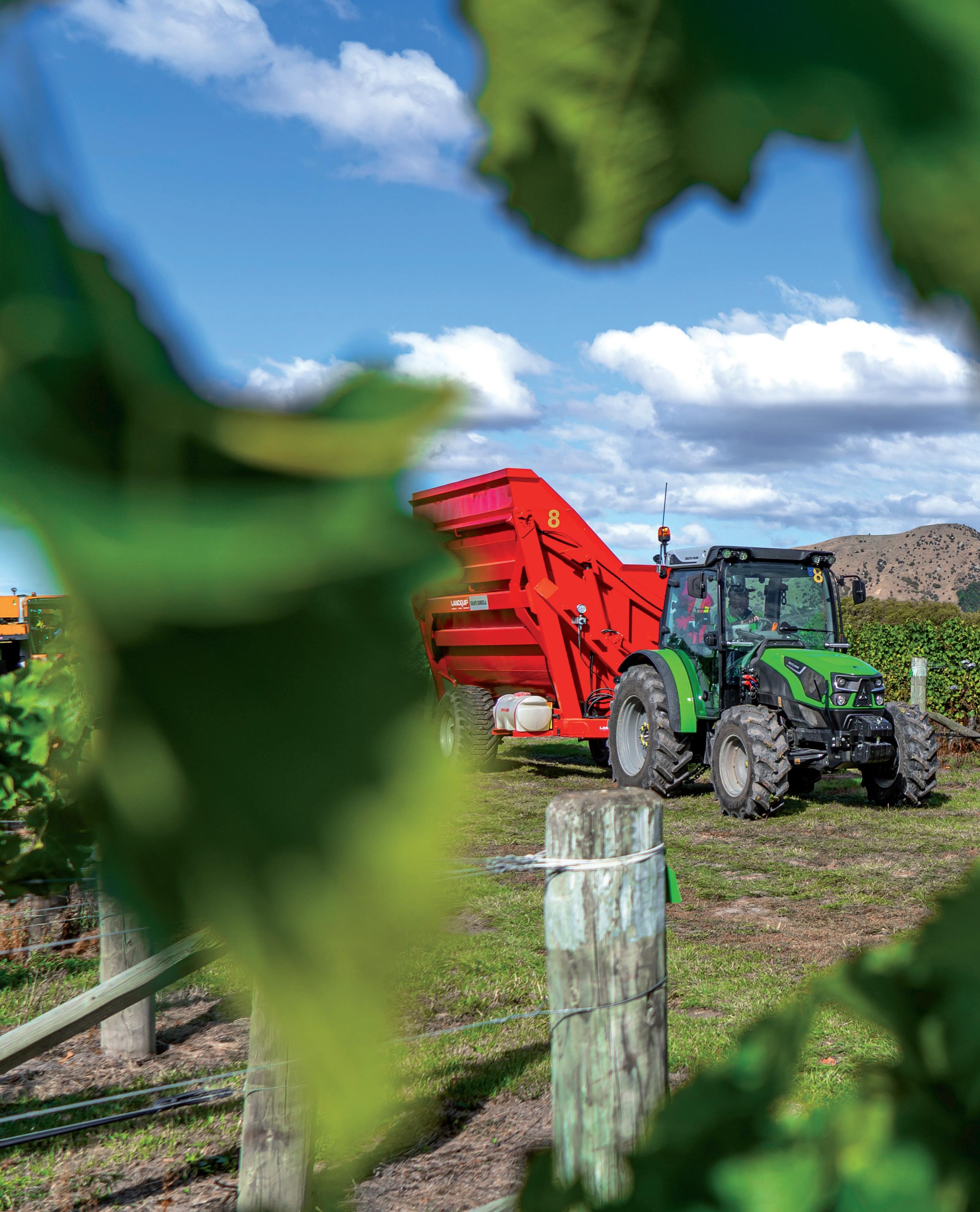
• Four available widths:
• 5100DV TTV from 1,077mm
• 5100DS TTV from 1,267mm
• 5100DF TTV from 1,441mm
• 5100D TTV from 1,795mm
Flat operator platforms, integrated armrest controls and climate air conditioning creates the ultimate operator comfort
Category 4 filtration systems. Electronically selectable, the air intake is diverted through the carbon filter while the operator can monitor filter charge and cabin pressurisation through the dash display.

“THERE DOES not appear to be any likelihood of vineyards starting up in Marlborough in the foreseeable future”. That comment from Marlborough County Council Livestock Instructor, S.G.C. Newdick in 1972, citing the glut of grapes in New Zealand, was swiftly proved short-sighted.
In 1973, having been thwarted in plans to buy several farms in Hawke’s Bay, Montana Wine’s Frank Yukich engaged land agent John Marris to purchase nine farms in 10 days at Brancott, Woodbourne and Renwick. Frank took the punt on the expert advice of viticulturist Wayne Thomas, and paid twice the going rate of $250 an acre, setting in motion the transformation of a region. Fifty years on, Marlborough has nearly 30,000 hectares of grapes, accounting for 71% of New Zealand’s vineyard plantings.
One of Marlborough’s driest summers followed, and water-cart irrigation of the plantings of mostly MüllerThurgau and Cabernet Sauvignon was not enough to get by, so that many vines had to be replanted. Undeterred, Frank trialled other plantings in 1975, including Sauvignon Blanc.
John Marris had meanwhile teamed up with Dutch migrant and energetic berry fruit grower Henk Ruesink to develop their own vineyards using trickle irrigation Henk had pioneered. By 1976, Montana had seen Ruesink-Marris vines harvesting spectacular yields compared to its average crops and began to trickle irrigate as well.
John was now Montana’s operations manager and sought contract growers. Among them were Judy and Neal Ibbotson, Chris and Phil Rose, Pat and Don Cromarty, Philippa and Neville McCallum, Kaye and Errol Hadfield, Marita and Max Gifford, David Dew, and John Lundon.
In April 1977, Montana’s winery was opened by Prime Minister Rob Muldoon and the same year the Grape Growers Association, later Marlborough Winegrowers Association and Wine Marlborough, was established.

In 1978 after battling some major objections around land use, Phil and Chris Rose finally gained consent and started establishing their vineyards. Then in 1979, Te Whare Ra was established on 4 ha at Renwick by Alan and Joyce Hogan as the first boutique Marlborough winery, with Riesling, Gewürztraminer and Chardonnay. Ivan Sutherland planted his first grapes and the same year Ernie Hunter acquired land for $3,000 a hectare on Rapaura Road.
While Montana Wines got it rolling, planting grapes in Marlborough was being discussed some years earlier. Te Mata’s John Buck was invited to speak to the Blenheim Travel Club in the late 1960s. Asked if vines could grow in Marlborough, he said if table grapes did ok, wine grapes could be grown on the Wither Hills. The Marlborough Express reportedly endorsed the idea in an editorial and John got a scolding letter from David Corban of the winemaking dynasty saying grapes would never work here.
Planting began in late winter 1973 and on August 24 Frank planted a vine at the official ceremony, famously predicting “wines from here will become world-famous”.
Marlborough’s Wine industry turns 50 this year, so we look back at some of the major challenges and monumental achievements over the past half century. To kick things off, BRENDON BURNS checks out the start of it all, with an overview of the 1970s.Frank Yukich placing a silver coin in the hole as the traditional token of good fortune for the new vine. Marlborough Heritage Trust - Marlborough Archives
When Phil Sutherland returned to his hometown of Blenheim in 1973, he was already confident the wine industry had a future.
In 1972 he and his new wife Lorraine had asked his aunt, Jean Rowberry, whether they could lease a few acres of her Dillons Point farm to grow grapes. “We even looked at borrowing some money to do it.” But Auntie Jean wasn’t keen, and little more than a year later, Montana was looking for people to develop its first Marlborough vineyards, changing the region forever.
Phil had hands-on knowledge of viticulture, having worked in Corbans vineyards in Auckland to get practical experience while doing his diploma in horticulture at Lincoln University. John Marris employed him in one of the three teams of around six people working at the Fairhall, Woodbourne and Brancott farms purchased for Montana. Allan Scott, who later founded Allan Scott Wines, acted as foreman for the Fairhall site where Phil was based. “We were basically wrecking the farms, stripping fences, trees and sheepyards,” says Phil, 50 years on.
A Ford 5000 tractor disced, ripped and rotary hoed the hundreds of acres before straight planting lines were established. “A guy with a rifle stood on a tractor with telescopic sights. He would line up the row, waving with flags to signal to the tractor at the other end.”

A wire was then stretched, sometimes as far as 500 metres, with tags to mark it. Then 40 or more people would take 10 vine cuttings at a time off a tractor tray to plant. Earth was mound around the plants and a wax covered cone was installed, to protect against rabbits and hares as well as retain moisture, says Phil. “That was all good until it blew like hell one night and the fences at Brancott were just thick with the cones. We had to pick them all up.”
Irrigating the vines involved a tank on a tractor with a 15mm hose. As the vines grew, teams banged in vine posts supplemented by thousands of hardwood stakes imported from Malaysia. A compressor was adapted to put in three at a time across each of two rows. “It was very much seat of the pants and as the need arose, something was made.”

Wire was rolled out with six spinning jennies being used at once, “so you couldn’t dare make a mess of it”, says Phil. Weeds were controlled by cultivation, supplemented by grazing. Phil helped drive a mob of 30,000 sheep from the A&P saleyards to Hawksbury.
After a couple of years, Phil got a job with the Department of Agriculture in Motueka. He still lives in the Tasman region, working as a horticulture tutor at Nelson Marlborough Institute of Technology, Te Pūkenga, but has never worked again in the grape industry. “Other things became more important.”
His aunt’s farm has long since become vineyards, and he occasionally thinks about what might have been, but with no regrets. “Today it’s all in grapes and it was great to be there at the start.”
IT’S 30 years since Bryan and Jan Johnson planted vines in the Waihopai Valley, and 20 since they founded Spy Valley winery in the heart of their vineyards. Throughout those three decades they’ve embedded an ethos of care throughout the company, says their daughter Amanda Johnson, managing director of Spy Valley Wines. “I would like to think that as a small family business we have always had a focus on our staff and known them well. My dad made sure he knew everyone’s names, and knew what everyone’s kids were up to. We always tried to be a tight unit.”
That culture of consideration came to the fore in the inaugural Marlborough Wine Industry Wellness Week in May, in which Spy Valley took out the Marlborough Wine Industry Workplace Wellbeing Impact Award for its Taco Tuesday event. The entire Spy Valley team of 35, including vineyard, winery and office crews, connected during a Mexican feast cooked up by Santiago Vadillo Reyes and the marketing team in the wake of harvest. From there they went through to the winery for a preview of the 2023 vintage straight from tanks and barrels, gleaning insights into the wines, but also the technology at use in the winery and lab.
Wine Marlborough advocacy manager Nicci Armour says the seemingly simple initiative covered several aspects of the Five Ways to Wellbeing – connect, take notice, give, keep learning, be active – and was “nourishing on multiple levels”. The judges applauded its inclusivity and accessibility, says Nicci. “Taco Tuesday is an excellent example showcasing that supporting wellbeing in the workplace does not need to be complicated or costly.”
Spy’s communal feast was devised for Wellness Week, but is a pretty typical event for the company, with previous initiatives including yoga in the board room, hula hoop
classes on the lawn, touch tournaments outside the cellar door, and vintage tastings for staff. Just weeks after Taco Tuesday there was a cricket match in the warehouse, which was empty for the first time in 20 years. A roller disco was on the cards for a while, as was a drive-in James Bond movie, but the pitch for a cricket clash – with teams a mix of office, winery and vineyard staff – took top spot, to the delight of winery manager Jassi Brar, who plays for a local team. “Literally everyone from all different departments showed up,” says marketing manager Della Offord, part of a crowd cheering from the side lines. The culture is also reflected in personal wellbeing activities, like the groups that head out for a walk in their lunch break, pick fruit for the smoko room if the vineyard’s plums and apples are ripe, or harvest produce from the communal vegetable boxes outside the winery.
Wellbeing, health and safety are all part of the company’s core values, which are listed in a large mural running down the hallway “to hold ourselves accountable”, says Della. The values were devised by the senior leadership team a month before Covid-19 hit New Zealand, then further developed through staff insights, some of which are quoted on the mural, such as: “flourish and prosper”; “speak up”; “show empathy”; and “respect others”. Amanda says everyone has their professional job at Spy, but the core values (which are considered in the employment process) challenge them all to consider their behaviours, with an expectation that everyone will “pitch in” to create a good culture.
Created on the cusp of Covid, the values proved key in the years that followed, as did the Employee Assistance Programme the company has long subscribed to, says Amanda. “We were very mindful of looking out for our people and their families during that period.” Now that

borders are open and restrictions largely lifted, the culture of care continues. When it comes to the push of vintage, Spy Valley offers meals and baking, like many companies, and uses an internal WhatsApp group, which was first established to engage staff isolated at home or in a bubble at work during Covid. This year Della ran a photo competition on the app to keep everyone engaged, connected and frequently amused.
Meanwhile, Amanda runs a tight ship when it comes to work schedules, with a hard and fast rule that no one works over their rostered hours at vintage, or misses a scheduled day off. “That’s really important to me; a. from a health and safety perspective, but also so people are getting proper rest and recovery.”
Talk in the smoko room this year reflected appreciation for that hard line, with several international cellar hands saying they had never worked a vintage without overtime and had always missed the breaks they needed. Amanda also makes sure staff who’ll work big vintage hours take time before and after harvest, so they’re rested in the lead up to vintage and can recover in the aftermath
Della says the company’s wellbeing ethos is rolled out in simple and effective ways, like an extra day of leave for birthdays, and the Covid leave implemented in recent years, ensuring that staff home with the virus didn’t use up their sick leave. And it’s also on a personal level, Della adds, recalling her daughter being in hospital and Amanda showing up at her front door with a home-made banana cake. They’re family values the managing director carries with her personally, “and is transferring as the mum leading the team”, Della says. “The key thing that shines through is that it’s very genuine.”
Judges in the Marlborough Wine Industry Wellness Week created a whole new award to recognise the leadership shown by Yealands in the wellness space, awarding them the Marlborough Wine Industry Workplace Wellbeing Leadership Award. Yealands’ many wellbeing initiatives will be profiled in the July Winepress.

There are many excellent initiatives already taking place in the industry, says Wine Marlborough advocacy manager Nicci Armour.
“Farmstrong partnered with Wine Marlborough for the week and were impressed by the industry-level approach to wellbeing and the good work taking place across so many workplaces.” Farmstrong resources, particularly suited for growers, can be found at farmstrong.co.nz.



SOPHIE PREECE
WITH NEARLY 30,000 hectares of Marlborough vines to be pruned this winter, grapegrowers should be strategic about when and how they work on individual sites. “If you have got hillsides, if you have got areas that are tricky to get done, do those first,” Dog Point Vineyards viticulturist and Marlborough Winegrowers board member Nigel Sowman told attendees at the Wine Marlborough Winter Field Day last month. “Get them out of the way while you can. It really makes a big difference at the end of the year.”

Nigel reflected on the 2022 season, in which some growers were unable to prune before budburst, due to 30 days of torrential rain and an inexperienced Recognised Seasonal Employer (RSE) scheme workforce, exacerbated by an additional 450ha of vineyard area. With a similar growth in plantings this year, the field day offered an excellent opportunity to grow understanding, he said. “This whole industry was built on sharing knowledge. We have people who know a lot willing to give up their time and share that knowledge for the best way forward. Everyone will learn something.”
Whitehaven viticulturist Jess Wilson and Plant & Food Research scientist Dion Mundy were among those sharing their knowledge, with a module on measuring and mitigating grapevine trunk disease (GTD) in Marlborough vineyards. Both of them are bemused at the number of companies not disposing of dead vines, protecting new vines, monitoring the incidence of trunk disease in every block, and painting or spraying pruning wounds. “And don’t prune in the rain,” said Jess, amazed at how many people ignored that advice. In the wet and labour-short 2022 winter season, growers may have felt pressured to prune in the rain, regardless of the risk of spreading trunk disease, she said. “This year we’re not in that space, but the other day when it was raining, the number of crews out there was ridiculous.”
Jess and Dion echoed Nigel’s advice to prioritise blocks, leaving any vineyards flagged for replanting low on the list. If people are under pruning pressure, they should only
consider those compromised blocks for wet pruning days, Jess said. “But don’t work on your good blocks in the rain.” Dion would be happy if growers would follow his simple list – reworking, wound protection, remove deadwood, monitor GTD, and don’t prune in the rain. Like Jess, he suggests growers consider which vineyards are due for a replant, perhaps because of virus, and put them lower on the pruning list. “Don’t make them a priority.”
Jeff Sinnott and Matt Gallop from Constellation Brands were also at the field day to talk trunk disease, with a module on replanting plans. Constellation has adopted a model where they can assess a block and discuss whether it warrants a full redevelopment, or go with a “grandad’s axe approach”, in which different parts are replaced at different times as necessary, said Matt. “It means looking at how we are dealing with the disease within the block and, if we are going to be planting new vines in it, how do we stop that new plant contracting that disease?” Constellation’s battle against trunk disease sees them undertake two rounds of wound protection through winter, with a spray after the Klima cut, then a paint after wrapping. Jeff said it was key to measure change, in order to consider the best course of action. There’s no hard and fast rule, as each vineyard has a unique set of situations, he added. “There are all sorts of decisions you make that all have different permutations.”
Logie MacKenzie and Vaughn Wolland from Berakah Vineyard Management spoke about mechanical pruning options at the field day, while Tanya Pouwhare, chief executive of New Zealand Ethical Employers, spoke about the continuing challenges faced by contract labour suppliers, including the need for 2,500 additional beds for Recognised Seasonal Employer scheme workers over the next five years. Viticulturist Mark Allen and Dr Carmo Vasconcelos, from Bragato Research Institute, spoke to attendees about alternative pruning methods, including new research around long spur pruning, while the final module canvassed freshwater farm plans.

Marlborough will host a new international wine trade event next winter, with the inaugural WinePRO to be launched in Blenheim in June 2024. With a tagline of ‘Vine to Wine’, WinePRO will showcase the latest products and technology in the wine industry, and connect leading suppliers with producers. It will also feature a dedicated conference programme and workshops to offer insights into the latest trends and advancements in the industry.
The event has been a vision of Wine Marlborough and the Marlborough District Council, with Mayor Nadine Taylor calling it an opportunity to celebrate New Zealand’s international reputation as a wine producer, “as well as cement Marlborough’s place as a hub of technology and innovation”. With the region accounting for more than 75% of New Zealand’s wine production, “Marlborough is the perfect place to host this fantastic new event”, she says. Wine Marlborough General Manager Marcus Pickens says there’s been a lot of positive feedback from industry members, who are pleased to have the event coming to the country’s leading wine region.
The organisers of the Winetech Exhibition in Australia are working with a local New Zealand-based team to deliver the inaugural event. Event organiser Gary Fitz-Roy, from Expertise Events, says WinePRO will unite the wine industry “face-to-face in the biggest wine region of New Zealand”. He hopes the event will be biennial and says the current plan is to hold the first three events in Blenheim. WinePRO will be held at Stadium 2000 in Blenheim from June 25-27, 2024. Visit winepro.co.nz or contact Gary Fitz-Roy for more information : garyf@expertiseevents.com.au

A NEW trial in Marlborough’s “innovation vineyard” is exploring the impact of biochar on soil and vine health. Marlborough Grapegrowers Cooperative (MGGC) viticulturist Johnny McMillan says the project, being run in collaboration with Nelson Marlborough Institute of Technology Te Pūkenga (NMIT), will explore the potential for sequestering carbon while increasing soil moisture holding capacity, nutrient stores and soil microbial activity.
Biochar is created through pyrolysis, heating organic material such as pine slash (but potentially also grape marc) to high temperatures without oxygen. The remaining matter absorbs carbon, and the International Panel for Climate Change has called biochar an important carbon removal technology.
Rothay Vineyard operations manager Jason Randall used biochar in the soil before planting a new block in spring last year, and set aside 10 rows for NMIT researcher and viticulture lecturer Dr Stewart Field to trial with students. Johnny says the innovation vineyard offers opportunities for students to further their research, while Stewart brings a “scientific head” to the cooperative’s projects. “It’s good extension from science to practical application in the field that we can then share with our members to improve what they are doing.” He says the cooperative wants to increase its members’ prosperity in many senses. “Not just dollars in the pocket, but increasing prosperity of their land and future generations.”
In the mainstream planting the biochar was mixed with mushroom compost and bark, then applied to the undervine area before planting, at a ratio of half a tonne of biochar per hectare. But when it came to the replicated trial, undertaken after planting, they applied the biochar in a variety of quantities, from half a tonne to 10 tonnes per hectare.
As well as a range of rates, they used two different types of biochar, and will consider the site as a long-term project, with NMIT degree students looking at vine growth and nutrition as the plants develop. Stewart and Dr Damian Martin, of Plant & Food Research, hope to source funding to assess soil biology under the varying biochar doses as well.
The MGGC is also running a water stress trial, with probes at five different sites in Marlborough – each with different soil types. There has been no irrigation on the sites, where measurements of canopy density and real-time soil moisture have revealed a higher tolerance for stress than typically triggers growers. “We have shown that real value can be added to your winegrowing by measuring both soil and vine water potential. By fine tuning you can not only use your water resource more sustainably, but potentially reduce other input costs while improving fruit and wine quality at no expense to yield,” Johnny says. They will continue the project, including through a dry year, “to see what thresholds we can hold to still maintain yield”.

James Dicey has been trialling biochar in Central Otago and will present his findings on in the implementation and effects at the Organic & Biodynamic Winegrowing Conference on June 22. organicwineconference.com
Superzyme and Rootella are our high potency biologicals that work together providing protection for new and mature vines.


TONY
It’s nearly 20 years since a major United States wine producer joined forces with a group of grape growers in Marlborough, changing the fortunes of both.


The Wine Group (TWG) began sourcing fruit from the Marlborough Grape Growers Cooperative (MGGC) in 2006, says TWG senior director of winemaking James Foster, who recently visited the region. “We’ve enlisted MGGC to carry out our sourcing on the ground. The collaboration with them, from where it was back in the day to where it is now, it’s been a tremendous success. Now we’re up above 9,000 tonnes [per harvest], and it’s been great to be part of this process.”
TWG executive vice president Dan Zastrow, who also visited Marlborough in April and met with MGGC growers, explains that when he joined the company around 20 years ago, its focus was primarily on entrylevel wines. Today, they hold 67% of the US market in that price range. In 2006 they began to explore various international regions, resulting in a focus on New Zealand Sauvignon Blanc due to its growing popularity. “The journey over the last 20 years has been to diversify into the higher price points, ensuring not all of our eggs are in one basket,” Dan says. “Our brand Cupcake was initially just Chardonnay for a specific retailer, but it took off, and we couldn’t keep up with it.”
When they added New Zealand Sauvignon Blanc to the brand, it also achieved significant success. An expanded partnership with the cooperative followed, and TWG became the central customer of the MGGC. The coop offers a unique model compared to large corporations, says Dan. “It’s more personal, more fun, and, to me, a more reliable model going forward.”
Dan and James emphasise the importance of continued growth and innovation, and want to develop more brands and potentially increase their tonnage. However, they also stress the significance of a balanced partnership, acknowledging the importance of the cooperative’s growth and diversity. “In hindsight, Cupcake was a marketing marvel, and now it’s a huge behemoth in the United States with huge successes,” James says. “And Sauvignon Blanc is our second-largest SKU in the whole portfolio, which is tremendous.”
NEW ZEALAND’S first B-Corp wine brand was born of a global pandemic, a national lockdown, and a bottle of terrible schnapps. “It’s lucky we’re not a quince schnapps company,” says Tiraki Winemaker Josh Hammond of his brother Tyler’s lockdown distilling, while grateful for the epiphany it provided.

The pandemic brought Tyler back to Marlborough from London, their sister EllaRose home from the United States, and good friend Chris Pratt back from Shanghai. The lockdown brought them together, and the quince schnapps – now compared to whiteboard cleaner – got them talking about a wine label, using grapes from the Hammond’s multigenerational family farm. “That really got the brainstorming going,” says Tyler. “We decided to switch this challenging situation to a bit of an opportunity and give it a crack.”
The discussion centred around an ethos of doing right by the environment and community they work in, says Josh. “First and foremost, we believe that the traditional business mindset of driving profits for shareholders is not a sustainable way to do business moving forward.” That set the scene for Tiraki, which means clearing of the sky in te reo Māori. “We came from a bit of a dark place, but turned it in to an optimistic space and cleared the skies,” Tyler explains.
The company achieved B Corp certification this year, after rigorous measurement of its social and environmental performance, transparency, and accountability. Having scored 102.5 overall, compared to the median score of 50.9, they now welcome the challenge of steadily improving those metrics, which is required for continued certification.
The Hammond siblings were raised on Longfield Farm in Fairhall, which has been in the family for five generations. Their parents Lynne and Rob planted grapes amid sheep and crops 24 years ago, when Josh was 12, Tyler 9 and EllaRose just 2. “We all spent a number of our holidays working the vines,” Josh says. “Doing basically
every job that needed to be done on the vineyard from a young age.”
They also grew up seeing their parents deeply involved in community and charities, which has come through in Tiraki, EllaRose says. The wine is bottled in Marlborough, and the company commits to purchase at least 50% of its core products from independent Marlborough suppliers. They also donate 2% of their revenue each year – currently to predator free projects Picton Dawn Chorus and Friends of Rotoiti – which is written into their bylaws, she says. “We have not set out to do this as a marketing thing. It’s how we will continue to grow our business and structure.”
Josh recalls an expectation that he would take over the farm one day, but instead studied law, with plans of a more urban existence, “not having anything to do with farming or viticulture or winemaking”. He wasn’t long out of university when he “saw the light” and realised that “being part of creating something was far more interesting than being a lawyer”.
His winemaking career was nurtured with vintages in Marlborough and abroad, including the establishment of the Renegade Urban Winery in London. On his return to Marlborough he worked with Native & Ancient organic wines at Isabel Estate, and now he’s making Tiraki, managing the family vineyards, and steadily converting a portion of the estate to organics, starting with Chardonnay and Pinot Noir this year, “because we believe that’s best for the environment and best for making premium wines”.
Meanwhile, Tyler is living in Amsterdam, EllaRose is soon to head to Europe, and Chris has returned to Shanghai, each perfectly placed for Tiraki’s success. But they remain kaitiaki of Longfield, EllaRose says. “We want to be the generation that continues the farm’s success and brings it to the world stage, and ensures it’s there for generations to come.”
tiraki.nzErica Crawford has seen “tremendous change” in New Zealand’s organic wine sector since Loveblock Wines entered the market in 2008. Speaking on the Wine Marlborough podcast in the lead up to the Organic & Biodynamic Winegrowing Conference, Erica talks of the growth in organic vineyard area domestically and the surge in market demand globally.
In the early days of Loveblock, Erica saw organic wines side-lined to specialty stores, such as Whole Foods in the United States. But she has watched it move to the “mainstream” in recent years, as consumers seek out organic products, along with the likes of sustainability and carbon neutrality.
In the recent Organic Matters magazine, published by Organic Winegrowers New Zealand (OWNZ), Erica noted that sales of wine in general are stagnant, but there’s sustained and significant growth in organic wine sales, albeit off a small base. Consumption of organic wine in France, Germany and the UK is predicted to grow 10% year on year to 2030, she says. The US market is harder to get a handle on, because of the difference in organic standards, meaning a lot of organic New Zealand wine is not recorded as such in that market. But the largest organic US producer is growing at 5%, with projections of greater growth going forward, reflecting a growing organic appetite, Erica says.
Organic viticulture consultant Bart Arnst – who is co-founder of OWNZ, co-founder of organic wine label The Darling, and co-chair of the upcoming conference – says the growth of certified organic vineyards is just part of the story, with organics influencing and educating many conventional and regenerative viticulture operations in New Zealand. Speaking on the podcast, Bart says throughout the three decades he’s been working in organics in Marlborough, he’s heard from people keen to
change the way they do things, and has seen winegrowing soften. He looks forward to more of those producers taking the final steps to organic certification, but “applauds” anyone looking to change in a positive way.
This year’s conference topics will range from regenerative organic viticulture to climate action, and from biochar to biological inputs, and seeks to assist winegrowers, winemakers and marketers, says Bart, who helped organise the first successful event in 2015. The programme is not designed to “shove things down people’s throats”, but to engage as many people as possible. “And even if you will never be organic in your life, we hope that there’ll be something there that you can take away and go, ‘oh, I could actually use that’.”
Its reputation has drawn interest far and wide, and Bart says it is easy to tempt experts from abroad, with the likes of Elaine Chukan Brown of Hawk Wakawaka Wine Reviews, Dr Andrew Smith from the Rodale Institute, and Johan Reyneke from Reyneke Wines in South Africa some of the 25 speakers at the event. This year’s conference will also raise money for the Gisborne and Hawke’s Bay Cyclone Gabrielle relief funds, with an auction at the gala dinner. Organisers had a goal of 20 magnums to auction off, and have ended up with 42 donated. “Everybody’s been really generous,” says Bart. “That adds a bit of fun, and hopefully we can show the industry up north that the rest of us acknowledge how tough it’s been for them.”
The Organic & Biodynamic Winegrowing Conference is on from June 20-22. organicwineconference.com

Find the Wine Marlborough podcast with Erica Crawford and Bart Arnst at marlboroughwinenz.com/podcast


The vitamin and mineral content of TCKP Natural Kelp Tea analysed by Cawthron Research Institute | September 2012
Analysis Result Units
Crude Protein 0 6 g/100
Aluminium 5 5 mg/kg
Arsenic 2.6 mg/kg
Boron 4 8 mg/kg
Copper 15 mg/kg
Iron 24 mg/kg
Magnesium 290 mg/kg
Nickel 0 66 mg/kg
Tory Channel Kelp Products' certified organic Natural Kelp Tea is a complete food for plants and soils.

Ideal for use in the vineyard via drip lines or as a foliar spray, and available in any quantity from 20 to 2000 litres in a single delivery to your preferred site.
www.torychannelkelp.co.nz | 027 445 3708 | sales@torychannelkelp.co.nz
Phosphorus 120 mg/kg
Potassium 3000 mg/kg
Rubidium 1 2 mg/kg
Strontium 22 mg/kg
Zinc 7.0 mg/kg
DESPITE GROWING up surrounded by vineyards in the Napa Valley, Ashley Stace vowed she would never take her father’s advice and work in the wine industry. Instead, she went to university and studied for a degree in kinesiology, in pursuit of a career in physical therapy. It wasn’t until she was a few weeks into an internship, shadowing a physical therapist, that she realised it wasn’t for her.
“Dad had worked in the wine industry on the production side for 25 years and was always trying to get me into it too,” Ashley says. “I was like ‘dad what are you thinking, there’s no way I’m going to do what you’re doing’,”
she laughs. “But after graduation, I picked up a job as a lab assistant at Simi Wines for vintage, so lots of ferment rounds and barrels. It was a pretty cool introduction to the industry - not that I told dad that right away.”

Having wet her feet in the industry, Ashley was invited to stay on at Simi, before finding a full-time position at Rodney Strong Vineyards in neighbouring Sonoma. Finding herself further immersed in wine, she decided she might as well dive right in and take some night classes in viticulture and wine business and technology at Napa Community College “While working with the winemaker at Rodney Strong, people started talking about travelling as a winemaker and how the job can take you almost anywhere,” she says. “New Zealand popped up as a possibility, so I applied for a work visa and next thing I was heading to New Zealand.”
Her first vintage in New Zealand was with Kim Crawford Wines in 2017, where she met a Kiwi bloke and fell in love with Marlborough. “I loved it, it reminded me of the Sonoma Coast and I felt very at home here early on - of course the boy helped with that,” she smiles.
For the next few years, she split her time between Napa and Marlborough, gaining as much experience as she could
in the wine industry, always working towards winemaking roles.
After successfully applying for the role of assistant winemaker at Spy Valley in 2021, she feels like she has “cracked” her goal and is right where she wants to be. “I love working in a small to medium vertically integrated winery, every day is different. I get to be very hands on and everything from the vines to the glass is basically under one roof.”
Having previously worked for teams as the youngest, or only female, working at Spy Valley which has an even gender ratio is “refreshing”, she says. “Spy has a reputation for being a friendly place for women to work - that’s one of the reasons why I jumped at the opportunity to work here.”
Six years after her first vintage in Marlborough, Ashley has married “the boy” and is looking forward to seeing where the wine industry leads her next. “Marlborough made a name for itself with Sauvignon Blanc and I’m constantly amazed by the variety of styles and expressions it can have,” she says. “There really is a Sauvignon Blanc for everyone and I’m fascinated to see where it goes next.”
“Spy has a reputation for being a friendly place for women to work - that’s one of the reasons why I jumped at the opportunity to work here.”
Ashley Stace
Ashley Stace



As part of a series of water updates, resource management expert QUENTIN DAVIES looks at what’s in store for the wine industry.


The irrigation of grapes in Marlborough relies on the ability to use ground water and surface water resources. That relies on the ability to physically access the water, the water being of an appropriate quality, there being sufficient quantity of water, and there being sufficient reliability of water supply.
On two of those counts, most grape growers in Marlborough are very lucky. The growing of grapes has very little negative effect on water quality. The national target set in the National Policy Statement for Freshwater Management (NPSFM) is that is that by 2030 80% of all lakes and rivers over a certain size are suitable for primary contact. By 2040 that figure is to increase to 90%. In Marlborough 98% of those rivers and 100% of lakes are suitable for primary contact. While there is still room for improvement, the growing of grapes in Marlborough has contributed to good water quality.
The growing of grapes has a low water demand when compared with growing other crops and pasture. That, coupled with good quantities of available water resources, means that, at current policy settings, there is likely to be sufficient water for all land capable of growing grapes in,
for example, the Wairau Valley. So long as grapes are not replaced by more water intensive crops, we are likely to have sufficient A class water approximately nine years in 10.
The most obvious challenge grapegrowers will need to face through the forthcoming freshwater variation process, from a grape growing perspective, is the reliability of water. The NPSFM 2020 requires the freshwater needs of the environment to be met first. Following this, the freshwater needs for human health (such as drinking water) are to be prioritised. The consumptive needs of crops, livestock and anything else are to be met from whatever is left.
Organisations such as Fish & Game take the view that Marlborough’s policy settings are inconsistent with the National Policy Statement. They take the view that, in dry periods, irrigation should be shut off earlier and restarted later. A Class water would be less reliable. Rather than shutting off for Wairau surface water takes when the river drops below 8m3/s measured at it is currently, they have argued that 12.4m3/s should be the minimum flow.
Fish and Game relies in part on the conventional wisdom that if adult trout are well catered for, then other aquatic life will also be. The argument, based on a series of studies and observations made on rivers across New Zealand and internationally, is that it is necessary to cease

taking water when the river reaches 90% of the mean annual low flow. 10.4m3/s is predicted to provide between 87% and 90% of the ‘natural’ habitat of adult brown trout, based on research undertaken for the Southland Regional Council. This and other research is then applied to the needs of dwarf galaxias and other native fish.
If Fish & Game are successful, then consequences on the viticultural industry will be immense. In the evidence which Wine Marlborough called before Council there was an approximate 5% loss in gross revenue in an average year. In an extremely dry year the revenue lost would be more like 50%.

As many people will know, even along a braided river like the Wairau, different conditions will be experienced as one travels up and down the river. Substantial changes occur between the confluence with the Waihopai and Tuamarina where a substantial part of the river flow goes into the Wairau Aquifer. At times at very low flow, this process reverses. A number of scientists have pointed out that the application of these theoretical models to a dynamic system like a river is challenging. It is even more challenging to apply lessons learned from rivers in, for example, Southland and apply those to Marlborough. A more recently published 10-year study in the Nelson Region has provided evidence that the driest summer did not have a consistent or unusually adverse effect on fish abundance.
The freshwater planning process has already started.
so cannot succeed. Arguments based on the value of viticulture, seeking to trade off the environment against economic values, will fail. Prudence dictates that we should use what may be dry summers between now and the hearing of the freshwater planning provisions to identify information which we anticipate will demonstrate the adequacy of the current regulation.
At the same time, we will need to be working with Marlborough’s tangata whenua iwi, MDC, and environmental organisations such as Forest and Bird and Fish & Game to see whether the freshwater provisions for Marlborough might be settled by agreement rather than by litigation.
Because of the foresight of those who imposed a regulation on Marlborough in the first place, coupled with the grape industry naturally having low impacts on freshwater we do not have the challenges that other regions face. We should use time available to attempt to reach a negotiated settlement while ensuring that we have the scientific information available to us should we have to demonstrate the freshwater credentials of the industry.
Quentin Davies is a partner at Gascoigne Wicks and has represented wine industry participants in numerous Court and Council hearings. He will contribute a series of columns outlining regulatory changes on the horizon. The views are his own and are not a substitute for independent legal advice
“The growing of grapes has very little negative effect on water quality.”
Quentin Davies

IN MAY 2017, New Zealand Winegrowers became the 13th industry sector to sign up to the Government-Industry Agreement for biosecurity readiness and response. As it approaches it’s tenth anniversary we reflect on the successes and progress of this a biosecurity partnership.
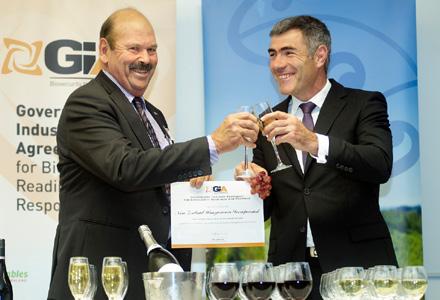

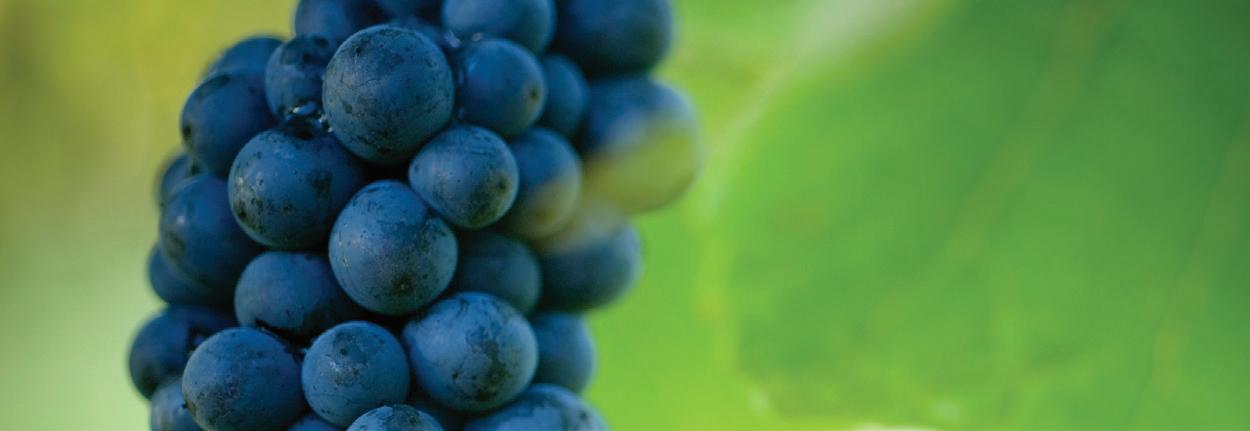
The Government-Industry Agreement (GIA) is a partnership agreement between the New Zealand Government and industry sectors that they will work together to manage unwanted pests and diseases that could harm New Zealand’s economy, natural environment and primary industry. It was first established in 2014. The GIA aims to improve biosecurity outcomes by allowing industry partners to share in decision-making in the post-border biosecurity system, in return for paying a share of the costs.
The partnership is governed by the GIA Deed, a legal document which provides the framework for close engagement between industry parties and the Ministry for Primary Industries (MPI) as the government representative, and details the high-level principles and arrangements for cost-sharing and shared decision-making. The Deed Governance Group oversees the implementation and improvement of the deed, and deals any with issues arising within the partnership. A separate organisation, the GIA Secretariat, has been established to provide secretariat services to the partnership and take care of admininstrative matters.
Underneath the Deed Governance Group, a series of councils has been established to design and implement readiness and response plans for a range of highpriority pests and diseases. The councils are made up of representatives from the sectors who benefit from the work of each. New Zealand Winegrowers (NZW) is a member of the Brown Marmorated Stink Bug (BMSB) Council, the
Xylella Action Group, the PlantPass Governance Group, the Lepidoptera Working Group and the Plant Biosecurity Council. Most GIA councils set their own individual strategies with pest-specific biosecurity outcomes, and use agreements called Operational Agreements (OAs) to outline the specific arrangements and legal detail agreed for costsharing readiness and response work for each pest. Sectors also have the ability to opt out of OAs if they believe they do not benefit from readiness or response work for a particular
threat. For example, NZW has decided not to sign the Fruit Fly OA, given fruit flies cannot survive the fermentation process and it is likely that a large-scale response to a fruit fly incursion would cause more strife to the industry than the pest itself.
Before the GIA, the Government made all decisions about biosecurity and funded all response activities. Limited pest-specific plans were in place, and funding for responses was always a challenge, creating delays and decreasing the likelihood of successful eradications. By working in partnership and ensuring funding mechanisms are in place, there is more certainty that high priority pests for the wine industry like BMSB and Xylella will be planned for, detected early and responded to in a timely manner. Decisions on

how to respond can be pre-agreed, resulting in faster and less costly responses which are more likely to be successful.
There are now 25 signatory organisations to the GIA Deed, representing the vast majority of primary producers, and the GIA has become established as the primary means for industry sectors to engage with the Government about biosecurity issues. Most partners are signatories to multiple readiness and response agreements and many strong working relationships have been formed amongst GIA councils and similar sector groups.
Response specifications have been developed for the wine industry’s top two Most Unwanted pests, BMSB and xylella, and cost-sharing arrangements for a BMSB response have been pre-agreed by the parties. A public awareness campaign funded through the BMSB Council has been running for several years now, and has been credited with increasing awareness and reporting of suspected BMSB across the country. A couple of BMSBs have been caught in surveillance traps near border facilities, saving a lot of time and resource by preventing the need for a largescale response to occur.
A plant nursery biosecurity scheme, PlantPass has been developed and implemented via the GIA partnership, improving the health and disease status of plants being distributed around New Zealand. The NZW Grafted Grapevine Standard was able to gain equivalence with this scheme so that grapevine nurseries can also become PlantPass certified.
Through the Plant Biosecurity Council, NZW can also work with other sector groups on proposals for future operational agreements for other unwanted pests, such as the spotted lanternfly and spotted wing drosophila. Collaborative readiness work has already been happening for both of these pests, even without OAs in place.
The GIA has become very complex, with multiple governance bodies and many operational agreements in place. Industry sectors see the value in collaboration and in cost-sharing with the Government to get preparedness plans and tools in place, so there is a ever-increasing need to prioritise proposed work for pests and diseases of concern. Many sectors are also nearing the limit in terms of the budget and resource they can commit to the current system. With the Biosecurity Act currently under review, there is an opportunity to consider what a successful GIA will look like in the future and perhaps restructure the partnership so that it remains efficient and fit for purpose. The Deed Governance Group continues to review the progress and success of the GIA and will further consider opportunities for improvement as the outcomes of the Act review come to light
You can read more about the GIA at: nzwine.com/ members/sustainability/biosecurity/gia/
ECO TRELLIS® posts have been thoroughly tested in vineyards for more than 14 years and are very strong and durable.
In contrast CCA treated wooden vineyards posts leach contaminants into ground water and are very hard to dispose of. They’re heavy to handle, damage easily and often bend and break under pressure in the vineyard.
A recent new style of vineyard post is untested, made from alternative product sources and may not be resilient to local conditions. These posts could be performing poorly in vineyards.

The inaugural Aotearoa New Zealand Chardonnay Symposium will be held in Te Matau-a-Māui Hawke’s Bay on October 5 and 6 this year. The symposium will bring together a national audience from the wine community to hear, taste and share knowledge on the domestic and international trends happening with Chardonnay. The New Zealand Society of viticulture and Oenology will deliver a technical workshop the first day, to be followed by an international focussed perspective on Chardonnay on day two. The Hawke’s Bay Winegrowers Association (HBWG) will also host the “Great New Zealand Chardonnay Celebration” in the newly refurbished laneways precinct of Toitoi on the evening of the October 5. HBWG chair Sally Duncan says the association is excited to be hosting the symposium, building on the region’s reputation “as one of the great wine regions of the world”.
hawkesbaywine.co.nz/symposium

A group of Marlborough producers is working together to showcase Chenin Blanc. Jaco van Hensbergen, from Merekara wines in the Awatere Valley, says there are eight companies making Marlborough Chenin Blanc at the moment, with another awaiting a new block of the variety to come on stream. Those producers are uniting to “showcase” Chenin Blanc in Marlborough, New Zealand and the rest of the world, says Jaco, who planted the variety in 2019 and now has his third year in the barrel. Merekara also produces Sauvignon Blanc and Pinot Noir, “but Chenin Blanc for us is our future”, he says. The new producer group had its first meeting in late May, in the lead up to International Drink Chenin Blanc Day on June 16.
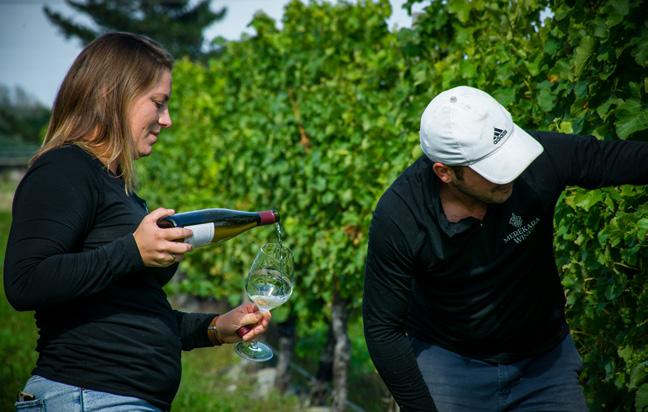

Steve Ross has been appointed as chief executive at Whitehaven Wine Company, after 14 years with the company, most recently as financial and operations manager. This year Whitehaven celebrates a 20-year partnership with North American winery and distributor E&J Gallo, having been the first New Zealand wine brand included in the portfolio. It started in 2003 with 50,000 cases and in 2023 will export nearly one million cases to North America, where Whitehaven continues to be one of the fastestgrowing New Zealand wine brands and was named an imported wine 2022 Impact Hot Brand for its double-digit growth in the ultra-premium wine category. Whitehaven managing director Sue White says looking to the future, the family-owned company has a focus on major restoration and regeneration projects to achieve its sustainability aspirations.
On or before Friday 11th August 2023
• Provide all members details of their voting group
• Provide a form for members to make changes to address, or change elector authorised to vote.
• Members only need to reply if a change needs to be made to the voter
• Return to WM office by Friday 18 August 2023
On or before 31 August
• Provide a candidate nomination form
• Return to WM office by Friday 8 September 2023
• If there are not more candidates than directors’ places available in any category, there will be no election for that category
1 September
• Last meeting of current board
15 September
• The Trustee will distribute to all electors a ballot paper listing candidates nominated for election on Friday 15th September 2023
2 October (by noon)
• Each ballot paper is to be returned to the Trustees office by Noon, Monday 2nd October 2023
3 October (by noon)
• Notification of Results
• The Trustee will advise WM by Noon, Tuesday 3rd October 2023 of the outcome of the election. WM will advise the candidates
3 November
• First meeting of new MWG Board of Directors at 8.30am
Two grapegrower seats and one wine company seat are up for re-election.
NICCI ARMOUR
Almost 200 volunteers from Lion New Zealand and hospitality venues removed 1,700 litres of rubbish from Aotearoa’s beaches and streets last year. In partnership with Sustainable Coastlines, targeted clean ups were

undertaken from down in Dunedin to Auckland’s city streets to Orewa Beach, north of Auckland City. Lion New Zealand’s sustainability advisor Lorietta Bahr says collective effort goes a long way. “We’ve supported The Sustainable Coastlines Charitable Trust for 10 years to improve the health of our oceans. Recently we broadened our efforts and invited the hospitality industry to join us.” Over the course of eight clean-up events, they collected enough litter to fill more than 13 bathtubs, she says. “We found everything from cigarettes and food packaging to old clothes, empty LPG gas bottles and broken toys.” Sustainable Coastlines CEO Josh Borthwick says, every volunteer creates a small ripple that builds larger waves of change. “Our corporate partners such as Lion are an important part of the work we do to clean up beaches and take action to reduce litter in our oceans.”
Marlborough had a stellar vintage in 2023 accompanied by several other positives for the industry. It’s terrific to see a return to normal cadence in some areas, including seasonal labour supply for vintage and winter pruning. June sees the arrival of the majority of RSE staff who come to Marlborough to support our pruning season, and this year we should see a better balance in overall numbers and experience levels. May saw the initiation f the first wine industry wellness week in Marlborough, with Spy Valley Wines and Yealands taking out the first wellness week awards. Collaboration across the industry and with our regional stakeholders is a real strength for the Marlborough wine region. Working with Marlborough District Council (MDC) has been very positive on a number of fronts, with the announcement of WinePRO, New Zealand’s own international wine trade event hosted in Blenheim, the establishment of a Smart + Connected Circular Wine group to tackle industry waste and sustainability, the facilitation and funding of a virtual reality wine video to promote the industry as an excellent career option, and a town hall discussion on seasonal accommodation options.
Freshwater farm plans are coming down the line and consultation on freshwater management as part of the RMA reform is underway. Continuing our positive relationships with stakeholders such as MDC and collaborating closely with New Zealand Winegrowers holds us in good stead to navigate any changes. However, as always, your engagement in these processes is key. If you would like to get involved and share your experience and knowledge as an industry business, please reach out to advocacy@winemarlborough.nz.
A monthly list of events within the New Zealand wine industry. Happenings, please email details to sophie@sophiepreece.co.nz by June 20. For more information, please go to the website supplied or email sarah@winemarlborough.nz

JUNE
16 International Drink Chenin Blanc Day (see page 26)
20-22 Organic and Biodynamic Winegrowers Conference (organicwinenz.com)


JULY

6 Young Viticulturist 2023 Competition Marlborough (nzwine.com/en/events/young-vit)
7 Fromm Enchanted Evenings, 4.30 to 7pm every Friday and Saturday night of July
18 Grape Days Marlborough (nzwine.com/en/events/research/grape-days)
AUGUST
28-30 Spray Days Marlborough (nzwine.com/members/events/workshops/spray-days)
30 Young Viticulturist National Final
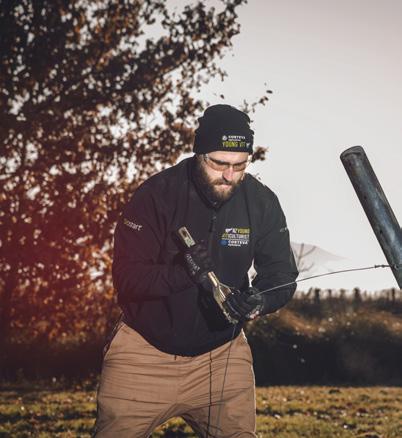
SEPTEMBER

15 Marlborough Winegrowers board election – voting begins (see page 27)

OCTOBER
2 Marlborough Winegrowers board election – ballot papers due back by midday (see page 27)

3 Marlborough Winegrowers board election – results notified
5 - 6 Aotearoa New Zealand Chardonnay Symposium, Hawke’s Bay


Our Fruitfed Supplies Technical Extension team works closely with our R&D team, growers and many industry groups.









Imparting knowledge from the wider industry, new product releases and R&D trials, the Extension team ensures our Technical Horticultural Representatives and store teams provide reliable and up-to-date technical advice to growers.




